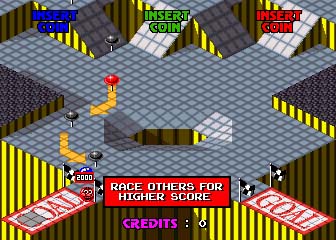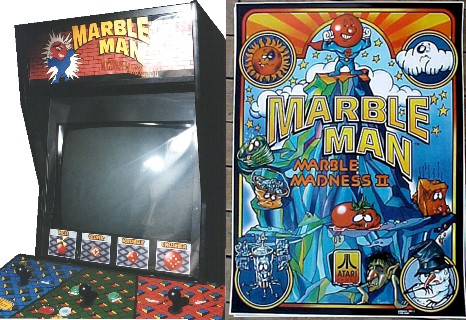Marble Man: Marble Madness II (found build of unreleased sequel of Atari arcade game; 1991)
Atari's 1984 Marble Madness was a successful arcade game which has maintained an avid cult following over the years. The game was widely acclaimed for its accessible but highly difficult gameplay, its early use of 3D-level designs, its music, and its entertaining addictiveness. The only real complaint of fans was that the game was too short, with only six levels available to play. A longer, more involved sequel was desired, and this was put into development, with the result being Marble Man: Marble Madness II, planned for release in 1991.
This was a whole new game with new features, many more levels than the original, and a mascot character, Marble Man. The game was completed and several arcade cabinets were built for location testing, a first generation including the original Marble Madness trackball control, and a second generation featuring a more typical joystick control.
However, Atari found that the popularity of fighting games such as Street Fighter II were dominating the market. It seemed that the gameplay of Marble Madness was considered outdated and uncool, and so it was permanently shelved in favor of developing a new fighting game, Guardians of the Hood.
Existing Cabinets
Several cabinets for Marble Man were created and are in fact still in existence. At least one private individual has suggested that they own one of these cabinets. Unlike most arcade games, Marble Man has never been available as a ROM, as no one who has access to the game data has been willing to make it publicly available for use.
Fans of the original Marble Madness continue to wait for a private owner to offer up a copy of Marble Man for copying. It is of some concern that if this is left for too long then the data in the arcade cabinets' CPUs will become damaged and will no longer be usable, although according to some sources, ROM dumps of the data have been made, but not publicly released.
According to arcade-museum.com, user atariscott of Roseville, CA possesses not just one, but two cabinets, of a suggested three known to exist, and they are in A-grade condition. According to the website, the other is assumed to be owned by developer Bob Flanagan.[1]
Another private collector who apparently owns a cabinet and has even created a ROM dump for his own private use and uploaded footage of the game is YouTuber phantomdj who may be or be in contact with, arcade-museum.com user atariscott.
Why it Was Never Released
It seems odd today that a developer would bring a game to completion, including creating all of the artwork and music and promotion for it, only to shelve it. However, it must be understood that at the time, the game industry ran on a very different financial and release model. Nowadays, the majority of the cost for a new video game goes into development. Games today routinely spend more on production than Hollywood films, after which they are released on cheap plastic discs which cost pennies each to produce, or are even downloaded, the only cost being bandwidth and server space.
Conversely, in the late eighties and before, games were developed very cheaply, usually with tiny teams of people, or even a lone creator, developing the whole game including characters, level design, physics, programming, writing and so on. Games were frequently created in a matter of months or weeks as opposed to years. The big cost for game developers was in producing the large, bulky cabinets to be shipped out to arcade rooms. These cupboard-sized units generally contained only a single game, so even if a game had been completed, developers had to be certain a game would recoup the outgoings on cabinet production before building hundreds or thousands of them. If a game was considered a bad sell, it was better to shelve it. The sacrifice of the time involved in creating the game was considered negligible in comparison.
It should be said, however, that Atari was considering the options of the now-available home console market. Unfortunately, they never went ahead with this new release model for Marble Man.
The Game
Since the main desire of Marble Madness fans was to have more levels, developers Bob Flanagan and Mike Hally created seventeen new levels for Marble Man.
As well as the new levels, a multitude of new features were introduced. Up to three players could play at once, like blue, red and green marbles, as opposed to the original game just having the red and blue marbles. The courses in the original were designed only for up to two players. For example, in Zone 4, the Aerial zone, each marble starts at the top of one of two thin ramps which they roll down and launch off of.
As well as the seventeen new main levels in the sequel, there were also to be pinball minigames between levels. Other interesting new features include the ability on some levels to become invisible, make one's marble giant, and to fly.
The Marble Man mascot, a superhero with a marble for a head, was apparently created with the idea of attracting a younger audience to the game. The original has a somewhat cold, scientific appearance, and since the main users of arcades were young, Atari considered it important to pander to this demographic.
Availability
On May 21st, 2022, the game was mysteriously dumped and uploaded onto the Internet Archive by a user known as Dank2079. While the game was still waiting to be added to MAME, Youtuber Jack Retro made a custom version of MAME to run the game and posted it in the description of their Marble Madness II video, before it was officially added to MAME in version 0.245.
Gallery
Images
Videos
External Links
- Original dump of the game by Dank2079.
- Github page of it being worked on for MAME.
- Jack Retro's custom copy of MAME that runs Marble Man: Marble Madness II.
References
- ↑ arcade-museum.com page on the game. Retrieved 09 Sept '13


